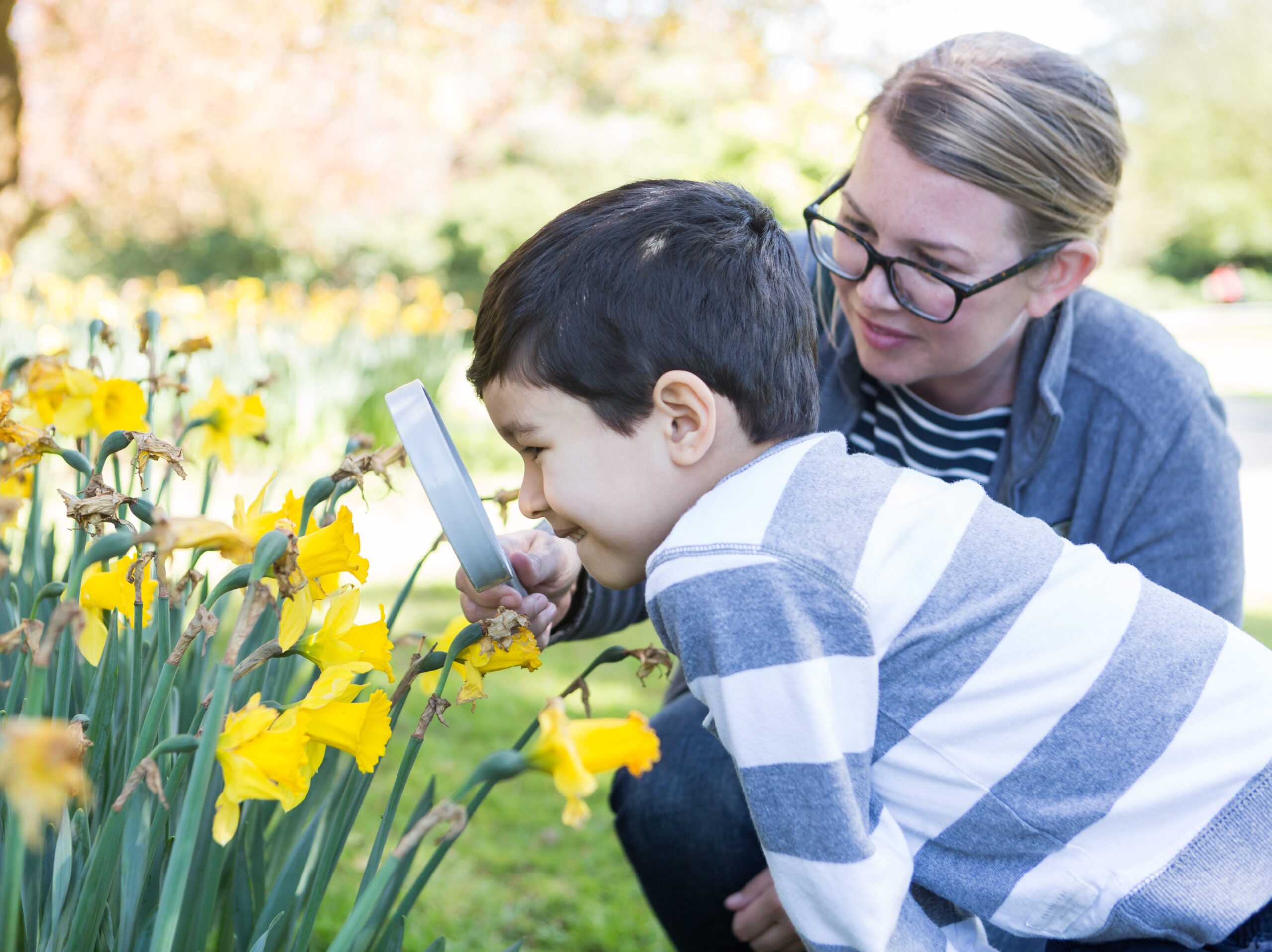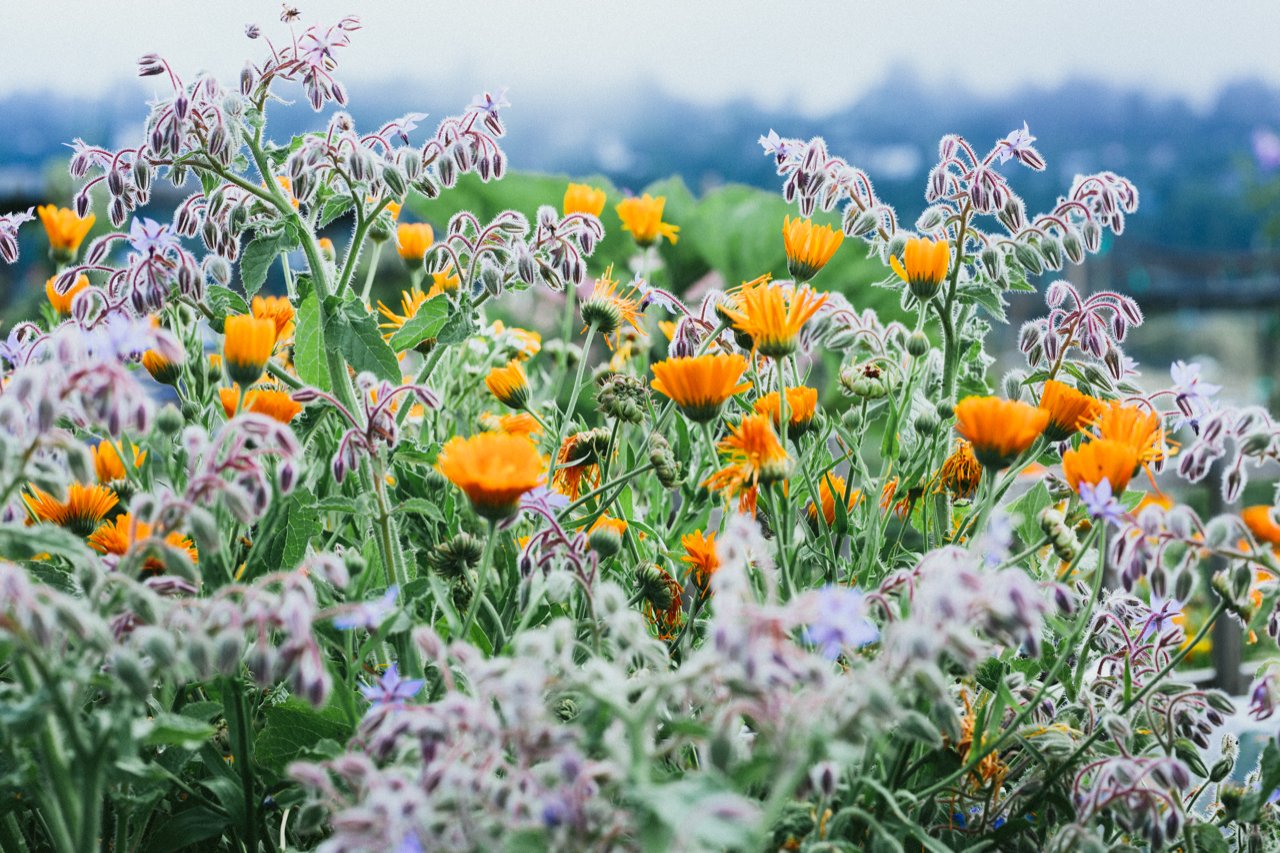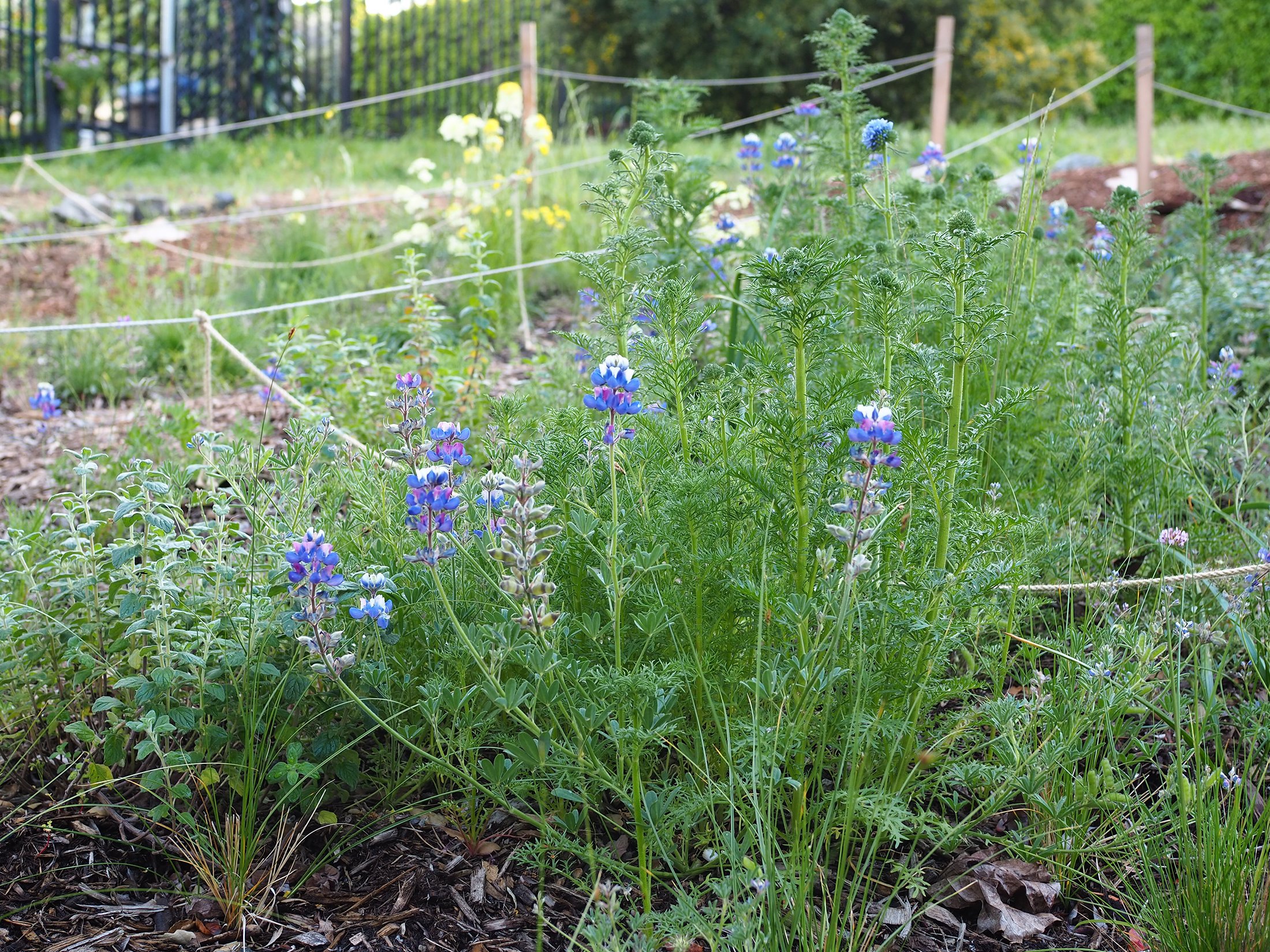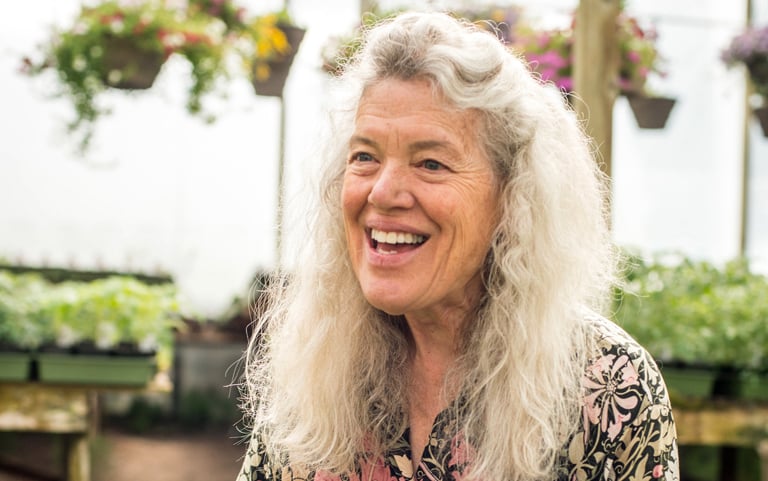

Contributor
- Topics: Archive, Sustainable Gardening

On a sunny day in May 2018, Kristyn Leach uncoiled a length of garden hose outside a greenhouse on her farm. With a baseball cap as her only shade, she hosed off several plastic seedling trays, which she planned to fill with a potting mix of her own making—part soil from the farm, part compost, and part rice hulls—before planting seeds for eggplants, soybeans, and long beans. Under the half-circle shelter of the greenhouse, seedlings in similar trays placed atop folding tables sprouted all around, their green leaves like tiny flags staking a claim on life.
That day, like most days, Leach, 35, worked alone on the farm with her dog Bebe, a Chihuahua-terrier mix who follows her through the farm’s two acres, which she leases from another farmer. She is tan from days spent out in the sun, working with her hands.
Leach’s Namu Farm is known for supplying organic produce to San Francisco chef Dennis Lee. Lee and his two brothers, the sons of Korean immigrants, run three eateries, with more on the way. Namu Gaji, an upscale but unpretentious American restaurant with Asian flavors, established Lee’s reputation as an innovative chef. Fresh ingredients, like the celtuce, red shiso, and Korean melons Leach grows for Lee, are key to his culinary vision—with dishes like a stonepot with rice, market vegetables, and housemade kimchee, or dumplings in a light sauce of butter, dashi, and nori. You can call it farm to table or slow food, but there’s much more to it than those labels suggest. Leach’s little farm is part of a growing movement of farmers and food professionals advocating for the preservation of plants, through a lens of culture and biodiversity, against big agriculture.
Namu Farm, which began seven years ago, is unique for its method of cultivation: Leach works without any machinery or fossil fuels, taking inspiration from traditional Korean farming. She recently moved the farm from Sunol, Calif., to Winters, in the western Sacramento Valley about 65 miles north of Oakland, where Leach lives. On her two alluvial acres, she grows lettuce, Napa cabbage Korean chile peppers, and more using only hand tools. While other farms create their own distinct ecosystems, Leach tries to integrate her plants into the native environment. She doesn’t till the soil, preferring to let roots and grasses decompose to improve the soil’s health naturally, and she doesn’t use pesticides or herbicides. So committed is she to this way of farming that she has even stayed overnight at the farm to stalk through the rows with a headlamp on her forehead, hunting the slugs that were devouring her perilla crop.

But Leach’s most important work is not in what the farm produces, but in what she’s learned while farming—and is now trying to share with others. She grows vegetables mostly from open-pollinated heirloom seeds that have been saved and passed down for generations. In contrast, most farms plant hybrid seeds that yield homogenous produce for mechanical harvesting. Leach offered the example of peppers: “A hybrid bell pepper is three inches tall and two inches wide because if it’s any bigger it gets cut off on the conveyor belt.”
Hybrids also self-destruct in a way. Their seeds produce wildly random results, so farmers must purchase new seeds season after season from the multinational chemical corporations that supply them. The worldwide rise of proprietary hybrid seeds has led to the decline in the diversity of our food supply. A study by the United Nations’ Food and Agriculture Organization estimates that 75 percent of crop diversity vanished between 1900 and 2000. Compounding this is climate change: How plants adapt to warming temperatures will determine the future of feeding the planet.
Seeds also carry the past; they are bearers of history and culture that reflect the migration of peoples. To Leach, preserving seeds for the sake of biodiversity is not enough. She also advocates for the preservation of the food and farming traditions of the different cultures that nurtured those seeds. A community that cultivates its seeds at a local level builds independence and resilience, all the better to survive the environmental challenges ahead for humankind.
When Leach is not farming, she’s convening and organizing others. The term grassroots seems particularly apt for a farmer-activist like Leach. She’s brought together a group of about a dozen people so far—seed stewards, she calls them. They are not starting a seed bank, she emphasizes, preferring a decentralized structure.
The group is decidedly made up of people of color, and are focused on heirloom varieties that are culturally significant, like saluyot, a leafy green used in Filipino cooking. Sita Kuratomi Bhaumik, a co-founder of the People’s Kitchen Collective, a project that uses food to educate and organize people around social justice issues, attended one of the group’s meetings, which included not only farmers and cooks, but also artists, all concerned about whether the foods they know and love will exist in the future. “What are people going to eat in a couple of generations and what is it going to taste like?” Bhaumik said. “And are they going to be able to eat the flavors that an entire people have recognized?”
Fellow collaborator Kellee Matsushita, 31, is a farmer and instructor at the Center for Agroecology & Sustainable Food Systems at University of California Santa Cruz. She and Leach had participated in the larger sustainable farming movement, but felt that it left out the voices of people of color.
“As is the case in a lot of aspects of the food movement, there is this almost white savior mentality being displayed where people feel like communities don’t know how to take care of their seeds,” Matsushita said. “So they come in, swoop them out, put them in a gene bank, maybe breed them out—but not necessarily in the ways that are serving the community.”
Leach worries that Asian American farmers, who have a long history in American agriculture—particularly in California—will get left behind, ironically, as Asian vegetables become more popular and trendy. She tries to convince other farmers to grow heirlooms not only for reasons of sustainability, but profitability too. One of the group’s projects this year is to survey chefs to determine what produce is in demand, and see if growers can be matched to restaurants.
Although Leach talks about farming in an expansive, philosophical way, it is also personal for her. Through farming, Leach, an adoptee, connects to a heritage that she didn’t have access to while growing up. Born in Daegu, South Korea, she was adopted by a white Irish Catholic family as an infant, and grew up in Long Island. A self-described “bratty anarchist teenager” in the 1990s, her involvement in the anti-globalization movement of the era led her to community gardens.
She moved west for college, spending eight years in Olympia, Washington, working on farms and entertaining her curiosity about plants. Plants felt magical. Why is it, she would wonder, that if you cut basil—or any plant in the mint family—it would sprout at the node where it was cut? “And so then I just went down a wormhole of studying soil biology and botany and getting really into it.”
Flipping through a seed catalog one day, she encountered perilla, a staple of Korean cuisine. Though she had not grown up eating the herb (a cousin to Japan’s shiso), she felt drawn to it. She ordered the seeds and planted them. Growing perilla made her feel connected to others in the Korean diaspora. At a community garden in Seattle, she noticed that perilla flourished on many plots that were tended to by ajummas, older Korean women. “Once you know something, you suddenly notice it everywhere. I can’t believe I was blind to it.”
By the time she moved to the San Francisco Bay Area, she was supplying perilla on the side to restaurants while working in the food industry. One of her customers was Dennis Lee. She told the Lee brothers that she was thinking about starting her own farm. Serendipitously, they had been considering partnering with a farmer, and fronted the money to establish Namu Farm.
Early on, Leach thought about ways to connect the farm to the Asian American community. She donated produce to the Asian Women’s Shelter and held storytelling events at the farm for Korean women from the shelter.
In 2014 she returned to South Korea for the first time since she left. For nearly three weeks, she traveled from farm to farm, learning about natural farming practices and political movements. Farmers shared their seeds with her. In Korea, she noticed that perilla, which she revered so much, was not treated as anything particularly special.
“It’s the most beloved and ubiquitous crop for a lot of Korean Americans. But in Korea, every farmer grows it for themselves, and everyone eats it. But there’s not the pining for something that you’re missing.”
Returning to the U.S., she began a partnership with Kitazawa Seed Company, a 101-year-old Asian-American-owned business specializing in Asian vegetables. Together, they preserve and distribute heirloom varieties. Their first releases were two chili peppers from Korea.
The rows on Leach’s farm are carefully spaced out and organized. This spring, on part of the farm, heads of lettuce grew one after another in parallel lines. From a distance, they appeared as a tapestry, woven with different shades of green. On another part of the farm, the soil still lay bare, awaiting the spring planting. The soil crunched beneath Leach’s boots as she walked up and down the rows, laying down irrigation tape.
Here, Leach planned to grow popcorn—not just any corn, but a variety called Glass Gem that produces ears with multiple jewel-like colors. It had been developed over many years by an Oklahoma farmer of Cherokee descent. She specifically sought out corn to plant because of its relationship to soybeans, a crop that’s close to her heart because of its importance in Korean history. Alternating soy and corn year to year helps both plants thrive.
The soybeans she grows are descendents of one variety that she brought back from Korea and has been replanting to multiply her seed stock. She started with just 20 to 30 seeds four years ago, and after saving all of her soybeans from the past few years for seed, she harvested four pounds of seeds last year. “They’re so unique to themselves. They’re grown by small farmers with no inputs in Korea. There’s not another bean that physically looks like them. They’re aesthetically really beautiful,” she said. The beans are dark brown with wavy white lines that seem drawn on them.
She also takes pride in growing these two particular crops “because corn and soy are so maligned because of our industrial food system.” They are viewed as the McMansions of agriculture, she says, destroying the landscape. “But they’re also cornerstone foods for multiple civilizations. There’s this other story of how abundant they are, how they are the most capable of growing without fertilizer. In reality they’re some of the most ecologically sophisticated crops.”
The farm yields more than enough for the Namu restaurants, so she has some room to experiment. For four years now, she has conducted different crop trials to see how a given variety responds to environmental stress. She will plant a crop, tend to half of it normally, and give the other half significantly less water. She gives seeds to others to test as well, so that they see how the same plants fare in different climates.

Kellee Matsushita received mustard green seeds that she plans to trial in Santa Cruz’s coastal climate. In the five years she has farmed in the area, she’s witnessed drastic changes. “Things have been getting more dramatic and more unpredictable,” with the weather tipping between historic drought and dramatic rains. “Farmers that I work with who have been farming here for the last 40 or 50 years are saying that it is so dramatically becoming erratic and problematic.”
Last winter season was extremely wet, leading to fungus issues. She’s also seen an increase in diseases and pests, like cucumber beetles. But it’s hard to point to any one thing as the culprit. There could be an explosion of a certain insect because their predator has died off. But why did they die?
“It’s almost difficult or impossible for us to actually point to the source sometimes because there’s so many complex ecological interactions in a diversified farming system.”
In other words, everything is connected.
In Leach’s own trials thus far, Chinese broccoli did not perform well with less water, but eggplants did. “I watched half of our crops be really unhappy, like I was torturing these plants.” But she saved the seeds from the unhappy plants and planted them again, and then again. “A fairly short amount of time later all of our eggplants are grown in that manner that that first set was subjected to. And now they’re just producing like normal.”
She thought that change would come slowly. That the eggplants adapted within a few years gives her hope. Still, she is cautious. If a crop succeeds on her farm, it doesn’t mean it will succeed everywhere. Plants and humans are intertwined. The plants on her farm respond to the systems she’s set up for them and the decisions that she’s made.
Taking a break in the farm’s greenhouse, she sits on a cooler, contemplating the eggplants.
“Things become attuned to you,” she said.
Further Resources
Center for Agroecology & Sustainable Food Systems
This story originally appeared on Popula.
Share:
Social Media
Garden Futurist Podcast
Most Popular
Videos
Topics
Related Posts

January Showers Bring February flowers…
Fall 2022 It may not quite have the same ring to it as the old English proverb, but it has a lot more truth to

Healing Gardens
Spring 2022 Emily Murphy believes gardens hold the key to saving our health, our communities, and our planet. In her new book Grow Now Murphy

Your Keystone Plant Matrix with Garden Futurist Doug Tallamy
Spring 2022 Listen to the full Garden Futurist: Episode XIV podcast here. If you take Keystone plants out of your local food web, the food

A Botanical Force
Listening to Alice Doyle recount the origin stories of Log House Plants’ most popular introductions, educational campaigns, and innovative collections is a great way to








Responses